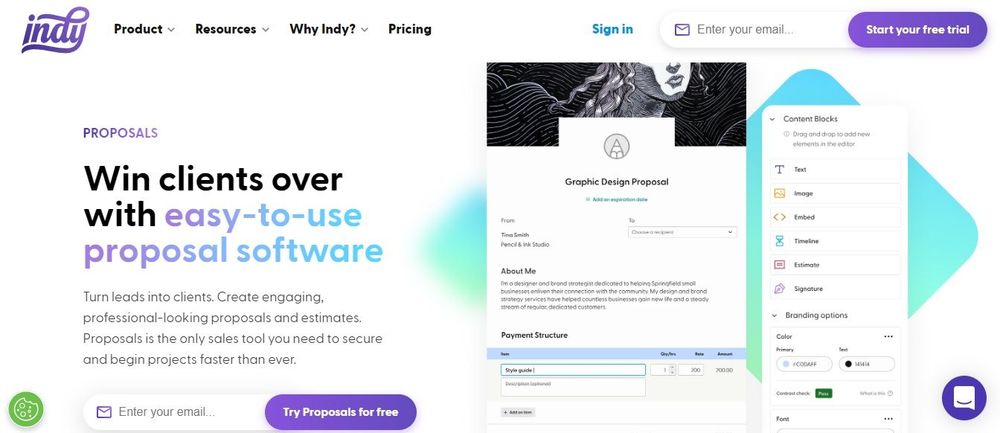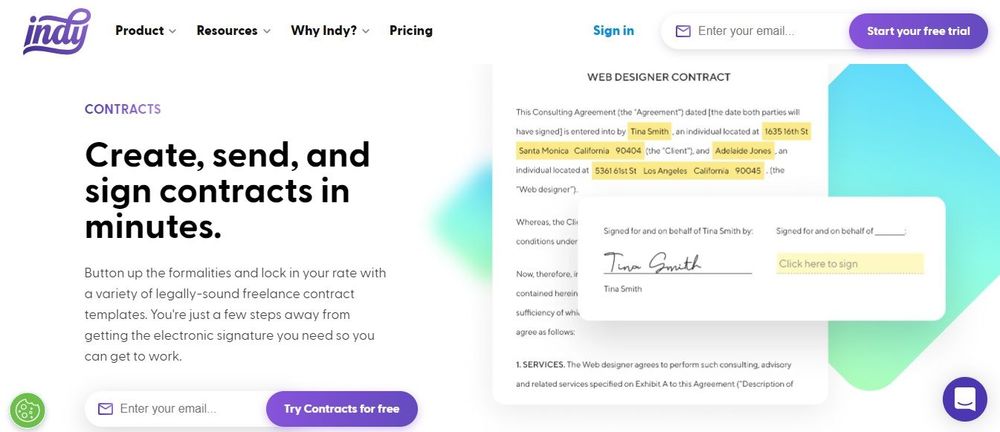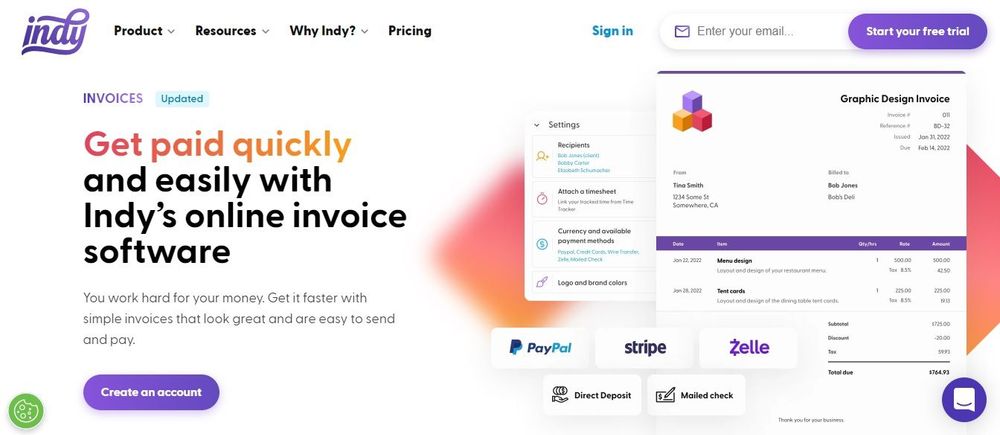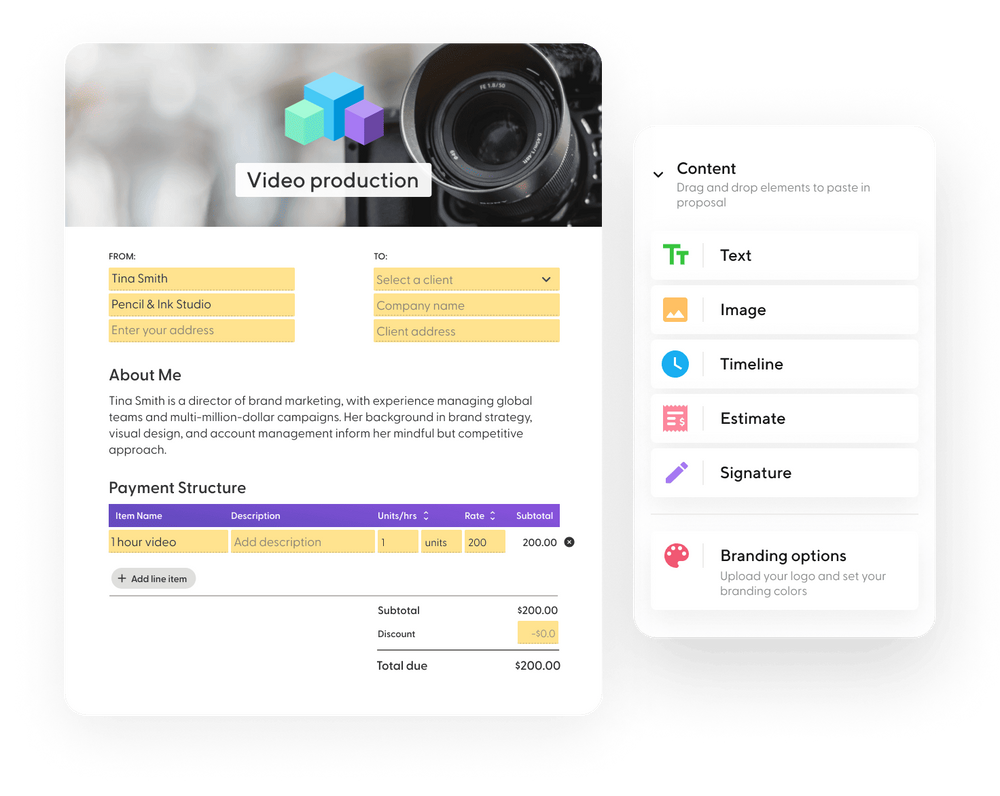The first step when trying to get new (or more) clients or freelance work is to have a solid consulting proposal. First impressions matter, and if you're a consultant in a competitive field, proposals can be the difference between landing a job or not. So you must get yours to stand out (in a good way, of course!).
When you have to write a consulting proposal for the first time, the task can seem a little challenging. What should you include? And how should you explain the steps, the costs, etc.? In reality, writing proposals gets much easier the more you do it, but it helps a lot if you have a solid foundation and a proposal example or two at hand. Here is where consulting proposal templates can make a big difference.
A consulting proposal template can help you stand out and have a substantial positive impact on your ability to apply for (and secure) freelance gigs. It can also protect you from misunderstandings down the road, especially if you use a legally-sound template like the ones we offer at Indy. You want to make sure your proposal includes all the scenarios that could put your business in danger (such as cancellations, amendment requests, etc.)
So let's first dig a little deeper into what a consulting proposal should include and why you should consider using a proposal template.
What is a proposal, and why do you need one?
The freelance industry is usually considered "top-heavy." Meaning that people who are just starting usually have a much harder time trying to land new jobs. For example, many consultants are forced to start with lower hourly rates or pay excessive fees to get noticed on freelancing platforms.
Things get easier once you start creating relationships with clients (we promise), but it might feel scary to know where to start if you're new to consulting. The good news is: You can jumpstart your consulting career by using a solid consulting proposal template and having a robust app by your side.
Proposals are essential for landing consulting jobs. They show you know your own skills and what you are selling, understand time constraints, and have clarity regarding your costs. A winning proposal displays professionalism and knowledgeability. It can impress potential clients and start a project on the right foot. So... how do you create one?
What's normally included in a consulting proposal template?
Most proposals follow the same structure. They are formatted as a brief overview (we will go into more details down below). The essential components of a business consulting proposal are:
- Your name and business
- Your contact information
- An overview of the work you will do and the expected outcomes, including all relevant steps and milestones
- (Sometimes) Work samples or a portfolio
- An estimated delivery date
- A fee summary
- Some terms and conditions
Essential things to do before you send your proposal
I know you want to get started right now. Hold on, though, for there are still a couple of important things you should consider before you sit down to write (or rather, edit) your winning proposal.
Let's take a quick look at three research opportunities that will help your chances. These are: knowing your strengths, reading the job description, and getting familiar with the client.
Know your strengths so you can find your ideal jobs
There is one secret many seasoned freelancers will probably happily share if prompted: You should always apply for jobs that you find interesting or jobs you know you are good at.

The best thing you can do before writing a consulting proposal is to review your experience and skills and make sure the job is a good fit for you and matches your expectations for consulting fees. And, of course, that you have a good chance of getting it considering your background. When you apply for a job that genuinely interests you, it usually makes it easier to sell your skills and abilities to a potential client.
Read the job description very carefully
Always, always follow instructions. If you want to write a good consulting proposal, you should always make sure you meet the job requirements. Otherwise, you might get quickly rejected - which could, in turn, lead you to second-guess your future business proposals.
There's also nothing wrong with asking your potential clients for clarification, especially if the description is incomplete or you're not sure if your proposed solution is a good fit. Many clients appreciate the effort as well.
Get familiar with the client
Before sending a consulting proposal, you should also consider researching the client. Dig deeper into the organization, its products, services, the team, etc.
What's their mission? What kinds of problems are they solving? And how would you fit in this scenario? Keeping these things in mind will help you create a proposal that speaks to them and makes you stand out.
Tips for choosing a consultant proposal template
It's always easier to use a proposal template rather than write a new one each time you want to contact a potential client for a new project.
There are many consulting proposal templates around the internet, but you should always make sure you're using one that can highlight your abilities and at the same time protect you and your client from potential issues.
When you choose a consulting proposal template, these are some of the things you should evaluate:
- Make sure your consulting proposal template is concise. Chances are the client is receiving a lot of them, and you want to make sure they don't skip yours.
- Use a proposal that has no unnecessary or forceful words, such as "very," "extremely," etc. It's also best if paragraphs are limited to two or three sentences.
- Always check the tone of the proposal - it should be written in a business-like fashion. The client will have the chance to get to know your personality better once you land the job.
- Confirm that your template includes delivery dates, milestones, fees, and terms and conditions.
The different elements of consulting proposal templates
We have mentioned some of the parts of a consulting proposal template. Let's go through them in a little more detail.
Your name and business
You should always open your consulting proposal stating your name and the name of your consulting firm or company. You don't want clients to have any issues about who wrote the proposal!
Your contact information
Clients need to know how to reach you. The second element of your proposal should always include all your contact information. It's best to add your legal address, email, and telephone number (with any relevant area codes) and your website if you have one.
Your client's name
The second element of your consulting proposal should be your client's name, their company name if there is one, and an address.
The proposal's expiration date
Many freelancers like to add an expiration date to all their consulting proposals. This can help you avoid misunderstanding if your prospective clients take too long to respond and you are, for example, no longer available to follow up on the project proposal.
The work to be done (description of services)
This is the most crucial part of your consulting proposal. The "Work to be done" section should be an overview of the work you will do and the expected outcomes. You should outline your strategy for the client (and do it, whenever possible, in an engaging way that motivates them to keep reading).
You should focus on the most important information and not go into too much detail. For example, if you're sending a marketing consulting proposal, you shouldn't state that you "will be able to boost your sales by 30%". You can't guarantee this will happen, and it's more likely the client knows their industry better and can quickly notice if numbers don't add up.

The deliverables
It's always a good idea to name your deliverables in your consulting proposal, so your prospective client knows what they will get if they work with you. For example, a deliverable could be a website, the development of an app, photographs, etc.
The timeline and estimated delivery dates
Due dates are an essential part of your consulting proposal. You don't need to be specific, but you should be able to provide your potential client with a rough idea of how long some activities usually take and what would come first.
A fee summary or payment structure
It's important to mention not just the total cost of your services but also the fee breakdown and any relevant payment information - such as payment methods, whether prospective clients can pay in installments, etc.
Terms and conditions
You can also include more specific terms and conditions in your consulting proposal. For example, any details regarding what is not included in the proposal or what happens if any of the parties wants to cancel the project before it begins.
Signatures
The last element needed for an effective consulting proposal is the signatures. Make sure you leave space for signing and adding names and dates.
Do you need a cover letter for your consulting proposal?
Some projects will benefit from including a cover letter when you submit proposals. You would typically send it as a separate document. You should keep in mind that this might be the first thing a prospective client actually sees when they open your message - so it's your best chance to make a first good impression.
It's better to keep your cover letter short and conversational. You can think of it as a sort of project summary and a chance to explain why it makes you, in particular, a good candidate for a specific project. Of course, it's okay to include a few project details and the project scope too, but the main goal of the cover letter is to introduce yourself, thank the prospective client for the opportunity to work with them, and explain what they will find in the consulting proposal.
Clients appreciate honesty, but you don't need to get too personal in your cover letter. While you're looking forward to getting the job, they just want to get their ideas done so they won't react positively to emotional appeals or a consulting proposal that doesn't include your skills and expertise.
For example, your cover letter could be something like this:
Dear [Client name or company],
Thank you for considering my services for your [Project name].
Given my [Experience description], I believe I have the perfect skills and tools to execute this project, and I'm confident I can deliver top-notch [Main deliverables].
You can find my proposal for [Project name] enclosed, which includes a detailed plan of activities for the next [Period of time] and all pricing.
If you have any questions, please reach out; you can find my contact information below.
Looking forward to collaborating with you,
[Your Name].
Creating your first consulting proposal template
You can create your consulting proposal directly as a document using software or apps like Microsoft Word or Google Docs. However, many freelancers and small business owners choose to instead use a sample consulting proposal template to make things a little easier and be able to reutilize their copies.
One of the main advantages of using consulting proposal tools is that they can automatically link your and your client's information and connect your proposal to other related documents such as contracts, invoices, etc. You can also usually add all important dates to your calendar and enable chats and messages with your clients so you can easily share files.
Our platform is a one-stop solution created with freelancers and small businesses in mind. So let's see how you can use Indy to create, send, and organize all your consulting proposals.
Using Indy to create and send your consulting proposals

One of Indy's most well-regarded tools is Proposals. Our platform allows you to create engaging, professional-looking estimates and consulting business proposals to secure and organize projects faster. And the best part? You can try them for free!
Indy's proposals are straightforward yet extremely powerful. You can start with a consulting proposal template (where you just update the info as needed based on your prospective client's problem, project schedule, etc.) or create yours from scratch.
Our free consulting proposal template and proposal tool features
When you create a consulting proposal or estimate with Indy, you can automatically convert it into an invoice as soon as it's accepted. Monitoring all your submissions is also extremely easy. You can tag and organize them as Draft, Sent, Read, and Approved, so you will always know who to remind or resend the files.
Creating your consulting proposals with Indy
You don't need much to write a consulting proposal using our platform. Just:
- Choose a proposal template (for example, a social media proposal, email marketing proposal, web design proposal, etc.).
- Add your proposal elements. We support:
- Text
- Images
- Embed files (songs, videos, mood boards, calendars, etc.)
- Timelines
- Estimates
- Signatures
- Customize all contents with your information, such as:
- Your information
- Your prospective client's information
- Your consulting experience
- The project deliverables
- Any legal terms and payment terms, etc...
Sending your consulting proposals with Indy
Once you've written your proposal, it's time to send it. The process is really straightforward: Fill in a few details and press a button (really, it's that simple!). You will be able to send your consulting proposal through email, using a shareable link, or download it as a PDF.
Monitoring your consulting proposals with Indy
Following up on all your proposals is easier than ever. Once you send one, you can always see its current status. For example, whether it's read, accepted, or declined. Every time a proposal's status changes, you will also receive an instant notification letting you know.
After your consulting proposal is accepted
If all goes right (and we're sure it will!), you should see your approvals roll in. So what comes next for your consulting business? Indy can help you plan all your next steps while keeping all your client and project information connected.
These are some of the things you can do with the platform once your business proposal is approved:
Create a project space
The first thing you can do is create a project space or a centralized dashboard for all your documents, files, client info, chats, etc. You can turn each proposal you have sent into a project space - so all your work is always neatly organized.
Create and send the contract

We don't only offer sample consulting proposal templates but also legally-sound contract templates and an equally powerful tool for customizing them. You can add project details, define payment terms, and get them sent in no time. And the best part? Your clients don't need to create an Indy account to sign them!
Create and send the invoice

Business proposal accepted and contract signed? Then we're almost ready. You can easily create an invoice for the initial deposit - and then manage all your future invoices from the same place. With Indy, you can accept all popular payment options such as direct deposits, checks, wire transfers, and debit and credit cards.
Create your tasks and get to work
And now it's finally time to start the actual job. Not only can Indy help you secure and create and send all your proposals, contracts, and invoices, but it also organizes your tasks and to-dos from our powerful, integrated platform. Get a clear picture of what's ahead, use time trackers to measure your work, chat with your clients in real-time, share files, and create forms all from the same app and connected to the same calendar.
Indy makes creating and sending consulting proposals easy and stress-free. Our platform will allow you to manage an entire project from beginning to end. We also offer numerous completely customizable free templates that can help you accurately describe the work to be done and create winning proposals. Our tools are perfect for freelancers and consultants starting a new business. You can try Indy for free or sign up for our premium plan (Pro Plan), which is just $4.49 a month.



